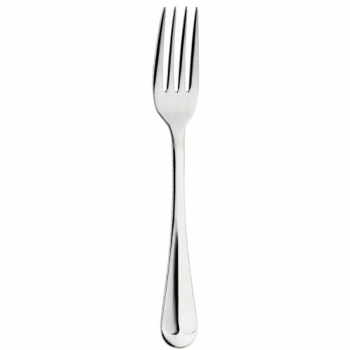Are you the kind of person with one set of all-purpose cutlery in the house? This often makes sense since home-cooked menus are often not that diverse and you may not entertain people that often.
But what do you do when you get an invitation to a fancy dinner?
Most likely you spruce up on your etiquette knowledge and you might start with forks.
Summary Table
| Salad fork | Dinner fork |
| Used for salads and vegetables | Used for the main course |
| 6 inches long | 7 inches long |
| Is placed to the left or right of the dinner fork, depending on when the salad will be served | All other forks are placed to the left or right of the dinner fork depending on when they will be served in the course of the meal |
| Has four tines, of which the outer one on the left is wider and thicker for cutting; or it can simply be a smaller fork with a corresponding knife on the right side of the plate | The biggest fork on the table, with a corresponding knife on the right side of the plate |
Descriptions

A salad fork is a small fork used for eating salads and vegetables; the salad fork may also have a one tine that is broader than the others. This tine is used to cut the salad and vegetables more easily.
The fork is approximately 6 inches long and its tines are broader and flatter compared to the rest of the forks on the table.
These tines provide leverage when cutting through large vegetables and lettuce leaves. Salad forks are used in formal and informal dinners. Some salad forks may also have one tine that is broader than the others. This tine is used to cut the salad and vegetables more easily.
Placement of the salad fork on the table depends on the sequence of courses. Therefore, for salads served after an entrée, the salad fork will be second on the left. For salads served as entrée themselves, the salad fork will be first on the left.

A dinner fork measures 7 inches in length and is used for the main course. Normally, the dinner fork has 4 to six equal tines. Also, it stands out on the table setting by being the biggest fork. These forks are used to eat the main entrée. They work well for meat, pasta, casseroles, and more.
All forks go on the left side of the plate, to left or right of the dinner fork. Placement to the left or right of the dinner fork depends on the sequence of courses before or after the main course.
Basic cutlery sets with forks, spoons, knives and dessert spoons will usually have only dinner forks which can used for everything, from fish to salad to desserts.
Salad fork vs Dinner fork
So what is the difference between a salad fork and a dinner fork?
A salad fork is used for salads and a dinner fork is used for the main course. They both have four tines (though some dinner forks can have up to 6 tines), although some salad forks sometimes have a thicker outer tine on the left for cutting lettuce and vegetables. See the picture below.

Normally, the salad fork does not have a corresponding knife on the right side of the plate. However, you may find a corresponding knife on the right side when the salad fork does not have the specific cutting tine. The dinner knife is longer than the salad fork. It has a corresponding knife on the right side of the plate and its placement indicates how many courses precede the main course.
Fork Etiquette Varies Between the US and Europe
Did you know that utensil use, including the use of forks, differs between the US and Europe? It’s true! Generally, the fork is held in the left hand with the tines pointed down and the knife in the right hand (whether using the salad fork or the dinner fork). The fork is used to pierce and bring food to your mouth, while the knife is used to cut food into smaller pieces.
On the other hand, in the US, the fork is held in the left hand and the knife in the right hand. This is done to cut the food. However, when it comes to putting food in your mouth, Americans lay their knives flat across the top of their plates and switch their forks to the right hand. We’ve heard this called the “cut and switch” manner of using eating utensils. It is a little confusing to visitors from Europe, but this is American utensil etiquette.
While the etiquette for using eating utensils can vary, it’s always best to follow your host if you’re unsure. Use the same silverware as your host, and you’ll never go wrong!





